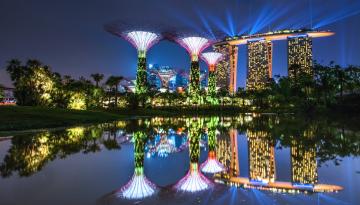One thing we have learned about the COVID-19 pandemic is the huge role mobile technology plays in monitoring it and, when possible, keeping it under control.
There's no doubt that ability will be the key to moving past the rules and restrictions we've all become accustomed to.
That said, if ever there was one place capable of rolling out digital infrastructure to monitor a virus, it would be Singapore.
Its years of popularity as a stopover for travellers going from one side of the world to the other will work in the country's favour as it deals with an influx of travellers post-pandemic. Even the sheer size of the Changi Airport itself means social distancing was essentially already happening there anyway.
Singapore Airlines is more than ready for progress to be made in the travel sector. Unlike many airlines, it doesn't have a domestic service to fall back on, so its future depends on borders opening up.
But it's also acutely aware of how delicate the opening of any border needs to be.
The airline's new Regional VP of South-West Pacific Louis Arul told Newshub the success of any quarantine-free travel bubble will rely on governments on both sides doing their homework, and for progress to be made step-by-step.
"It could be that vaccinated New Zealanders in Singapore may be able to return home without the need to enter MIQ, or it could provide the opportunity for international students to return. If it is a broader opening, then it may allow Kiwis to holiday, or businesses to reconnect face-to-face with a head office or global hub," Arul said.

"It may allow Singaporeans to rediscover New Zealand, which would help stimulate economic activity and support the restart of the international tourism sector."
Arul says there are two hurdles that need to be overcome in order for Singapore to join Aotearoa's travel bubble. The first is confidence in the safety and systems put in place, while the second is how well each country manages its vaccination rollout as well as any future community transmission.
A successful overall COVID-19 management strategy will result in increased traveller confidence.

"The bridge to re-connecting Singapore and New Zealand is already half-way built as Singapore has been unilaterally open to New Zealand since October last year," Arul said.
"Anyone who has been in New Zealand for 14 consecutive days only needs to apply for an entry visa and then undergo a COVID-19 PCR nasal swab on arrival and isolate until a negative result is returned. This type of unilateral opening is Singapore's way of saying, we're ready when you are, but as we know, it takes two hands to clap."
Aotearoa may seem like an odd place for a global airline to focus on, but the numbers of passengers flying between it and Singapore were steadily increasing year-on-year as the Asian nation's popularity for stopovers, as business hub and more recently a destination in itself increased.
Singapore Airlines and Air New Zealand both flew more than once per day between the two pre-pandemic, and Singapore Airlines has been flying to Auckland since 1976.
"Both countries have achieved success far in excess of their size. I think both countries at a government-to-government and at a person-to-person level have respect and admiration for each other," Arul said.
Once we do get to a position of expanding our circle of safety, travel to and from many countries will become a reality, and Singapore and its airline seem determined to make sure they're at the top of the list.
"Critically, what needs to happen is for industry, government and key stakeholders to come together and work collaboratively on developing and agreeing on the parameters for a bubble or corridor to operate. Once these are agreed then we will all have a clearer understanding of when it may be viable for it to be actioned," Arul said.
In 2000, 35,000 people arrived in New Zealand from Singapore. In 2019, that figure had nearly doubled and was forecast to surpass 80,000 in 2025, before the arrival of COVID-19.
The pandemic saw arrivals from Singapore into New Zealand drop to just 9000.




